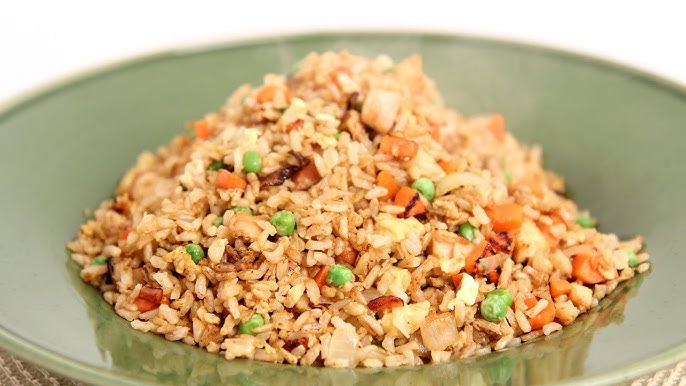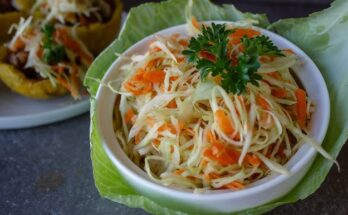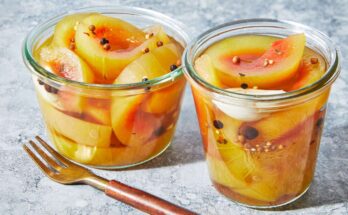Brown Rice Recipe: Brown rice is the whole-grain version of white rice, where only the outermost layer—the hull—is removed. This minimal processing means brown rice retains its bran and germ, making it a fiber-rich, nutritious alternative to white rice. If you’re trying to eat healthier without giving up your love for rice, brown rice is the perfect go-to. Not only is it healthier, but it also has a nutty flavor and chewy texture that adds depth to your dishes.
Brown rice is more than just a healthy grain. It’s a way to fuel your body with slow-releasing energy, reduce the risk of heart disease, and improve digestion. Whether you’re meal prepping or just want to try something new in your kitchen, this recipe will walk you through making perfectly fluffy brown rice every time.
What is Brown Rice?
Brown rice is essentially rice in its most natural form. Unlike white rice, it retains its bran layer and germ, which are packed with nutrients. That’s why it takes longer to cook, but the extra time pays off in taste and nutrition. It’s a whole grain, which means it provides complex carbohydrates that keep you feeling fuller longer and prevent blood sugar spikes.
There are various types of brown rice—short grain, long grain, and medium grain. Each has a unique texture and slightly different cooking times. Long grain brown rice is fluffy and separate when cooked, while short grain tends to be more tender and sticky.
Health Benefits of Brown Rice
Here’s where brown rice truly shines. It’s loaded with essential nutrients like magnesium, phosphorus, selenium, thiamine, niacin, and vitamin B6. It’s also rich in fiber, which aids in digestion and can help with weight management.
Some of the standout health benefits include:
- Heart Health: Brown rice contains lignans that help reduce heart disease risk.
- Weight Management: The fiber content helps you feel full, curbing overeating.
- Diabetes Control: It has a lower glycemic index than white rice, making it better for blood sugar control.
- Digestive Health: The insoluble fiber helps keep your digestive system running smoothly.
So, not only are you making a tasty choice—you’re also doing your body a favor.
Ingredients You’ll Need
Making brown rice is simple and doesn’t require a long grocery list. You probably already have everything you need in your kitchen.
Main Ingredients:
- 1 cup of brown rice (long grain preferred)
- 2 ½ cups of water
- 1 teaspoon of salt (optional)
Optional Add-ons for Flavor:
- 1 tablespoon olive oil or butter
- Garlic cloves or powder
- Bay leaf or other herbs
- Vegetable or chicken broth instead of water
Using broth instead of water is an easy way to infuse extra flavor into the rice, especially if you plan to eat it as a standalone side dish.
How to Prepare Brown Rice – Step-by-Step Guide
Step 1: Rinse the Rice Thoroughly
Always rinse your rice! This removes surface starch that can make your rice gummy and sticky. Place the rice in a fine-mesh strainer and rinse it under cold water for at least 30 seconds, or until the water runs clear. This also helps remove any debris or dust.
Step 2: Soak the Rice (Optional but Recommended)
While not mandatory, soaking brown rice for at least 30 minutes can significantly improve the texture and reduce cooking time. Soaking softens the grains and makes them fluffier once cooked. If you have the time, don’t skip this step. Just soak the rice in a bowl of water and drain it before cooking.
Step 3: Measure the Water and Rice Ratio
Unlike white rice, brown rice needs more water due to the outer bran layer. The ideal ratio is 2 ½ cups of water for every 1 cup of rice. If you soaked the rice, reduce the water slightly to about 2 ¼ cups. Add a pinch of salt for taste.
Step 4: Cooking the Rice on the Stove
Bring the water and rice to a boil in a medium saucepan. Once boiling, reduce the heat to low, cover with a tight-fitting lid, and let it simmer for 45-50 minutes. Don’t lift the lid while it’s cooking—this releases steam and messes with the cooking time.
Step 5: Let it Rest and Fluff
Once the water is absorbed and the rice is cooked, remove the pot from heat and let it sit, covered, for 10 minutes. This resting period allows the moisture to distribute evenly. Then, fluff the rice with a fork to separate the grains and serve.
Tips for Perfectly Cooked Brown Rice
Want that ideal, fluffy texture every time? These tips will help:
- Use a pot with a tight-fitting lid to trap steam.
- Don’t stir the rice while it’s cooking—it makes it mushy.
- If your rice ends up too wet, uncover the pot and let it sit over low heat for a few minutes.
Common Mistakes to Avoid
- Using too little water (it’ll turn out hard).
- Lifting the lid repeatedly (this disrupts the cooking process).
- Skipping the resting time (your rice won’t fluff properly).
Time-Saving Hacks
- Use a rice cooker or Instant Pot for a hands-off approach.
- Soak rice overnight to cut cooking time in half.
- Make a big batch and freeze in portions.
Serving Suggestions
Brown rice is incredibly versatile, making it a staple in kitchens around the world. Whether you’re aiming for a full-on feast or a light, nutritious bowl, there are countless ways to enjoy brown rice.
Best Dishes to Pair with Brown Rice
Brown rice serves as the perfect base or side for a variety of dishes. Here are some delicious pairings that complement its nutty flavor and chewy texture:
- Stir-Fried Vegetables: The earthy flavor of brown rice pairs beautifully with colorful veggies like bell peppers, broccoli, carrots, and snap peas. Drizzle with soy sauce or sesame oil for an Asian-inspired bowl.
- Grilled or Baked Proteins: Think grilled chicken, baked tofu, salmon, or steak. Brown rice acts as a hearty foundation that complements lean proteins wonderfully.
- Curries and Stews: Whether it’s Thai red curry, Indian chickpea masala, or a slow-cooked beef stew, brown rice soaks up those savory juices like a pro.
- Salads and Bowls: Mix brown rice with fresh veggies, beans, corn, and avocado for a power-packed grain bowl. Add a zesty dressing and you’re good to go.
- Stuffed Peppers or Tomatoes: Replace white rice in your stuffed veggie recipes with brown rice for a healthier twist and added texture.
Creative Ways to Use Leftover Brown Rice
Have leftovers? Don’t let them go to waste! Here are some clever and tasty ideas to reuse cooked brown rice:
- Brown Rice Fried Rice: Sauté with scrambled eggs, veggies, soy sauce, and a touch of sesame oil.
- Rice Soup: Add to broth with chopped veggies and herbs for a comforting soup.
- Rice Patties: Mix with cheese, breadcrumbs, and an egg to form into patties. Pan-fry until golden.
- Rice Pudding: Combine with milk, cinnamon, and a touch of honey or sugar for a sweet dessert.
- Stuffed Burritos or Wraps: Brown rice adds bulk and nutrition to any burrito or wrap filling.
These easy recipes make meal planning a breeze and ensure you get the most out of every grain.
FAQs about Brown Rice Recipe
1. Is brown rice healthier than white rice?
Yes! Brown rice is considered healthier because it’s a whole grain, retaining its bran and germ. That means more fiber, vitamins, and minerals like magnesium and B vitamins compared to white rice.
2. Why does brown rice take longer to cook?
The outer bran layer of brown rice is tougher than white rice, so it naturally takes longer to soften. Soaking it beforehand can reduce cook time slightly.
3. How do I make brown rice less chewy?
Use the right water-to-rice ratio (usually 2.5:1), and simmer it gently. Let it sit covered for 10 minutes after cooking to absorb residual moisture—this makes it softer.
4. Can I cook brown rice in a rice cooker?
Absolutely. Most modern rice cookers have a “brown rice” setting. If yours doesn’t, just add a bit more water and allow extra cooking time.
5. What dishes go well with brown rice?
Brown rice pairs beautifully with stir-fries, grilled chicken, vegetable curry, sautéed greens, or even as a base for burrito bowls.
6. How long can I store cooked brown rice?
Keep it in an airtight container in the fridge for up to 4–5 days. For longer storage, freeze it in portions—it reheats like a dream.
7. Is brown rice gluten-free?
Yes! Brown rice is naturally gluten-free, making it a safe and hearty grain option for gluten-sensitive or celiac individuals.
Conclusion
Cooking brown rice doesn’t have to be intimidating. With the right steps and a little patience, you can achieve fluffy, flavorful brown rice every single time. It’s a nutrient-packed grain that brings health benefits and culinary satisfaction in equal measure. Whether you’re pairing it with hearty proteins, mixing it into salads, or simply enjoying it as a side, brown rice is a wholesome addition to your meal routine. Give it a try—once you master it, you’ll never want to go back to plain white rice.



